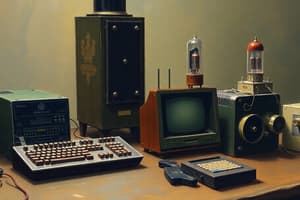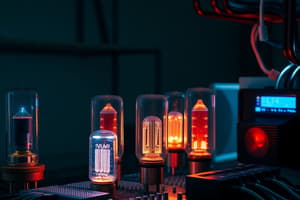Podcast
Questions and Answers
What was a notable feature of the second generation of computers?
What was a notable feature of the second generation of computers?
- Usage of vacuum tubes
- Introduction of integrated circuits
- Use of transistors (correct)
- Microprocessor technology
Which of the following was a disadvantage of first generation computers?
Which of the following was a disadvantage of first generation computers?
- Larger size and expense (correct)
- Magnetic tape storage
- Low power consumption
- Used air-cooling technology
Which technology was prominent in the third generation of computers?
Which technology was prominent in the third generation of computers?
- Microprocessors
- Vacuum tubes
- Transistors in large quantities
- Integrated circuits (correct)
What major advancement did the fourth generation of computers introduce?
What major advancement did the fourth generation of computers introduce?
Which of the following programming languages were primarily used in the second generation of computers?
Which of the following programming languages were primarily used in the second generation of computers?
What was a feature of the fifth generation computers?
What was a feature of the fifth generation computers?
Which challenge was specifically associated with the second generation of computers?
Which challenge was specifically associated with the second generation of computers?
Which computer was an example of the third generation?
Which computer was an example of the third generation?
What is the primary function of the CPU in a computer?
What is the primary function of the CPU in a computer?
Which type of memory is considered volatile and loses its data when the power is off?
Which type of memory is considered volatile and loses its data when the power is off?
What distinguishes cache memory from other types of memory?
What distinguishes cache memory from other types of memory?
Which type of memory contains programs essential for the operation of a computer and cannot be changed by use?
Which type of memory contains programs essential for the operation of a computer and cannot be changed by use?
What is the purpose of input/output devices in a computer system?
What is the purpose of input/output devices in a computer system?
Which of the following is an example of secondary storage?
Which of the following is an example of secondary storage?
What characteristic defines primary memory?
What characteristic defines primary memory?
What is the role of busses in a computer system?
What is the role of busses in a computer system?
What is the main disadvantage of a hardwired control unit compared to a microprogrammed control unit?
What is the main disadvantage of a hardwired control unit compared to a microprogrammed control unit?
Which statement accurately describes the speed of the control units?
Which statement accurately describes the speed of the control units?
Which type of microprocessor typically utilizes a microprogrammed control unit?
Which type of microprocessor typically utilizes a microprogrammed control unit?
What component holds the opcode of the currently executing instruction in a CPU?
What component holds the opcode of the currently executing instruction in a CPU?
What is a key benefit of using a microprogrammed control unit?
What is a key benefit of using a microprogrammed control unit?
In the steps required to execute a program, what is the first action taken?
In the steps required to execute a program, what is the first action taken?
Which statement about control memory in CPU architecture is true?
Which statement about control memory in CPU architecture is true?
Which register holds the address of the next instruction to be fetched?
Which register holds the address of the next instruction to be fetched?
What does MIPS stand for in computer architecture?
What does MIPS stand for in computer architecture?
What is one characteristic of Complex Instruction Set Computers (CISC)?
What is one characteristic of Complex Instruction Set Computers (CISC)?
Which of the following is NOT a type of Instruction Set Architecture (ISA)?
Which of the following is NOT a type of Instruction Set Architecture (ISA)?
In a RISC based processor, what is the primary focus of the instruction set?
In a RISC based processor, what is the primary focus of the instruction set?
Which statement is true about Reduced Instruction Set Computers (RISC)?
Which statement is true about Reduced Instruction Set Computers (RISC)?
How is performance defined in terms of execution time?
How is performance defined in terms of execution time?
Which statement best describes how MIPS is calculated?
Which statement best describes how MIPS is calculated?
What role do registers play in the operation of a RISC processor?
What role do registers play in the operation of a RISC processor?
What does 'throughput' refer to in computer performance?
What does 'throughput' refer to in computer performance?
Which of the following enhances a computer's response time?
Which of the following enhances a computer's response time?
In which architecture is the most significant byte stored at the lowest address?
In which architecture is the most significant byte stored at the lowest address?
How many general-purpose registers (GPRs) does a typical RISC based processor have?
How many general-purpose registers (GPRs) does a typical RISC based processor have?
In the context of execution time, if computer X takes 10 seconds and computer Y takes 15 seconds to run a program, how much faster is X than Y?
In the context of execution time, if computer X takes 10 seconds and computer Y takes 15 seconds to run a program, how much faster is X than Y?
Which of the following is a common attribute of RISC architectures?
Which of the following is a common attribute of RISC architectures?
What is the standard data type size for a word in the described architecture?
What is the standard data type size for a word in the described architecture?
Which statement about CISC processor design is accurate?
Which statement about CISC processor design is accurate?
Flashcards are hidden until you start studying
Study Notes
First Generation Computers
- Achieved a processing speed of 5000 additions per second.
- Utilized machine language for programming.
- Depended heavily on vacuum tubes, which were prone to generating heat and consuming large power.
- Notable drawbacks included their large size and expense.
- Examples include ENIAC, EDVAC, IBM-701, and IBM-650.
Second Generation Computers
- Operated from 1956 to 1963 and introduced transistors, a 1947 invention from Bell Labs.
- Transistors provided cost-efficiency, reduced power usage, compact size, reliability, and speed improvements over vacuum tubes.
- Employed magnetic cores for primary memory and magnetic tape/disks for secondary storage.
- Advantages included reduced size, increased speed, and the ability to save instructions in memory.
- Programming utilized machine and assembly languages like COBOL and FORTRAN.
- Air conditioning was necessary due to heat, and they were mainly for commercial use.
- Examples included IBM 7049 Series and CDC 3600.
Third Generation Computers
- Spanned from 1964 to 1971, characterized by integrated circuits (ICs) comprising numerous transistors on a silicon chip.
- Offered increased speed, reduced size, greater reliability, and less heat generation.
- Integrated circuits allowed interaction with I/O devices and were often accompanied by operating systems.
- Examples include IBM System/360 and PDP-8.
Fourth Generation Computers
- Marked by the introduction of microprocessors in the early 1970s, with over 100,000 transistors on a single chip.
- Intel's 4004, an early four-bit microprocessor, led the way for subsequent models like 8008 and 8086.
- Notable features included VLSI technology, portability, high speed, and significant accuracy and reliability.
- Compatible with large memory interfacing.
- Examples included a series of Intel processors and AMD processors.
Fifth Generation Computers
- Focused on artificial intelligence applications post-1988, featuring ULSI microprocessors and nano-meter technology.
- Employed high-level languages such as C, C++, Java, and .NET.
- Noted for faster processing, decreased costs, intelligent capabilities, and parallel processing.
- Examples comprised desktops, laptops, and Chromebooks.
Computer Memory
- Primary memory includes cache and is categorized as temporary or permanent storage.
- RAM (temporary storage, lost when powered off) and ROM (non-volatile, contains essential programs).
- Cache memory is smaller and faster, storing frequently accessed programs.
- Secondary storage (e.g., hard drives, DVDs) is slower but offers permanent and larger capacity for data.
CPU and Control Units
- The CPU performs arithmetic and logic operations and executes instructions from memory.
- Two primary control unit architectures: hardwired (faster but more complex) and microprogrammed (more flexible).
- Different types of registers exist, including general-purpose and specialized registers like IR, PC, MAR, and MDR.
Instruction Execution Process
- The program execution involves fetching, decoding, reading operands (if necessary), executing operations, and writing back results.
Performance Metrics
- MIPS (Million Instructions Per Second) measures execution rate, inversely related to execution time.
- Performance is defined as 1 divided by execution time.
Architecture Classification
- Distinctions between CISC and RISC architectures based on instruction complexity and handling.
- Execution time affects perceived performance, specifically through response time and throughput.
Memory Addressing
- Memory addressing involves understanding big-endian (most significant byte at lowest address) and little-endian (least significant byte at lowest address) formats for data storage.
Example: Instruction Comparison
- CISC: Directly operate on memory banks with complex instructions and addressing modes.
- RISC: Focus on registers with simpler instructions emphasizing hardware efficiency.
Studying That Suits You
Use AI to generate personalized quizzes and flashcards to suit your learning preferences.




